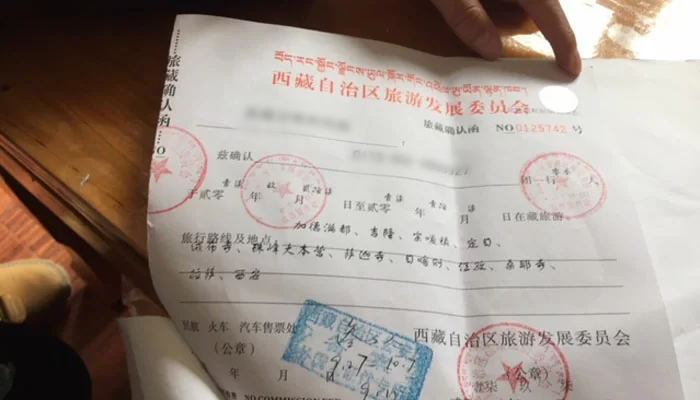A Mount Kailash trek is a challenging and meaningful journey through some of the most beautiful landscapes in the world. It is a tour of a lifetime, but it’s good to be ready in advance. Permits, terrain, weather, packing are all things you need to be aware of for a successful and pleasant trek. To help you prepare and know what to expect, here are 10 important tips you absolutely need for a Mount Kailash Tour.
1. The best time to do a Mount Kailash trek is in spring and autumn.
The weather in Ngari can be uncompromising at certain times of the year, so the best times for taking this amazing trek are from April to early June (spring) and late September to the end of October (autumn). These are the times when the weather is dry and pleasant, with clear skies and almost no rain to interfere with your trekking.
 Spring and autumn are the best times for Mount Kailash trek.
Spring and autumn are the best times for Mount Kailash trek.The trek can also be done in summer, as the area around Ngari sees very little in the way of monsoon rains, though there are times when it can get pretty wet in late July and August. Unless you can be sure of good weather, it is best to stick to spring and autumn. Winter is definitely out, as it can get too cold in this region of Tibet, and there is often snow by the end of December, making the pass almost impossible to cross.
2. Besides Tibet Travel Permit, other permits are needed for Mount Kailash trek.
Permits are required for trekking around Mount Kailash, but you have little to worry about when it comes to getting them. All visitors to Tibet are required to be on a pre-arranged tour with a registered Tibet tour operator, and it is the tour operator that obtains the permits you need on your behalf. The permits you need for the Kailash Kora trek are:
Tibet Travel Permit – This is required for entry to Tibet and to travel around the area of Lhasa.
Aliens’ Travel Permit – Required for travel to the “unopened” areas of Tibet outside Lhasa, including Shigatse.
Foreign Affairs Permit - This is a must for visiting sensitive borders such as Mt. Kailash and eastern Tibet.
Military Permit - Required for travel to the military-sensitive areas in Tibet, such as Ngari (Mount Kailash, Lake Manasarovar, etc.), Nyingchi and Chamdo.
These permits are all included in our tour package, and we will assist with the application process to ensure a smooth journey to Mount Kailash. However, please note that the Tibet Travel Permit requires approximately 15-20 days for processing, so it is advisable to book well in advance.
3. The best way to get to Mount Kailash for trek is from Lhasa via overland.
To get to Mount Kailash for the holy trek, you can start your journey from either Lhasa or Kathmandu, depending on your entry point into Tibet.
If you're coming from Kathmandu, you have two options. You can travel overland from the Gyirong Port border with Nepal to reach Mount Kailash in Ngari. Alternatively, you can fly to Lhasa and then continue the journey overland to Mount Kailash.
 Getting to Mount Kailash via overland from Lhasa follows a smooth road.
Getting to Mount Kailash via overland from Lhasa follows a smooth road.If you choose to start from Lhasa, you'll embark on a picturesque overland route covering approximately 1,577 kilometers. The drive takes around four days, with stops at various attractions along the way, including the famous Mount Everest Base Camp.
For most tourists, traveling overland through Lhasa to Mount Kailash is the best way to get there. The journey travels through some of the beautiful and unique landscapes in the world. You can stay overnight at Everest Base Camp seeing the towering mountain under the stars, see some of Tibet’s high-altitude lakes like the holy Yamdrok Lake, and unique sights like Karola Glacier.
Our most popular 15-day Mount Kailash tour includes a visit to the iconic landmarks of Lhasa, a trip to the majestic Everest Base Camp, the lifetime 3-day Mount Kailash kora trek, and exciting Tibet highlights along the route. It's an ideal option for trekkers of all levels who want to experience the incredible beauty of Mount Kailash.
4. The Mount Kailash kora trek typically takes 3 days to complete.
The Mount Kailash Kora trek starts and ends at Darchen village, located below the sacred mountain's southern face. Covering 52 kilometers in three days, the trek takes you past three Buddhist monasteries: Chuku, Drirapuk, and Zutulpuk. On the second day, you'll cross the highest point, Dolma La Pass, between Drirapuk and Zutulpuk, while exploring the scenic river valleys of Lha-chu and Lham-chu.
Day 1: Darchen - Dirapuk Monastery (trekking 13 km)
The trek starts at Darchen, where you will take an eco-bus to Sarshung Valley. Then you will meet the yaks and porters at Sarshung village. After everything settled down, you will start the trek from Sarshung to Drirapuk Monastery.
 Mount Kailash kora trek starts from Darchen village.
Mount Kailash kora trek starts from Darchen village.The trek route follows the mountain's southern edge along the Lha-chu Valley. You can take your time on the trek up to the first camping ground, at Drirapuk, as the route up the valley boasts some of the best scenery of the entire kora.
Day 2: Drirapuk Monastery to Zutulpuk Monastery (trekking 24km)
After spending the night camping or staying in the monastery guesthouse, day two of the trek presents the most challenging section. Today, you will conquer the high pass of Dolma La (5,630m), where prayer flags and mani stones adorn the pass, offering breathtaking views of the Gangdise Mountain Range, which are unparalleled in Tibet.
 Views of the Gangdise Mountain Range from Dolma La Pass
Views of the Gangdise Mountain Range from Dolma La PassThe pass is a place for a rest and a cup of tea to revive ailing limbs, before starting the steep descent down to the Lham-chu Valley and the next stop at the Zutulpuk Monastery. After about three hours of trekking from the pass, you will enter the grassy fields that herald the next rest stop.
Zutulpuk Monastery has camping grounds for trekkers who are camping the route, and the lush fields make it a great place to camp for the night. The monastery also has a good guesthouse for those that like sleeping in a bed.
Day 3: Zutulpuk Monastery to Darchen (trekking 12km)
After a good night’s sleep, the final day of the trek follows the river valley closely for a little more than an hour, before climbing up above the river to a narrow canyon.
The canyon has some interesting holes dug into the sides, where pilgrims dig to look for holy Mani stones, and the entire canyon is strung with prayer flags from one side to the other. After you reach Zongto, you can take the bus back to Darchen, and finish the trek.
5. One can stay in the monastery guesthouses during the Mount Kailash trek.
Darchen does have hostels and guesthouses, so you can get a good night’s sleep before starting the trek. While there are guesthouses along the kora route at Drirapuk and Zutulpuk, during peak seasons or holy Tibetan festivals, these guesthouses may be fully occupied.
Fortunately, both monasteries also have awesome camping sites in lush grassy fields below the monasteries, close to the river. Camping is a popular way to spend the night, and you can sit and relax in the evening watching the stars in the night sky before turning in for the night.
 There are monastery guesthouses and tent houses along Mount Kailash kora route.
There are monastery guesthouses and tent houses along Mount Kailash kora route.6. There are simple restaurants offering food along Mount Kailash kora route.
One option for food along the kora route are the monastery guesthouses. Zutulpuk Monastery often only has instant food available, but Dirapuk Monastery will sometimes have simple food such as bread, egg noodles, vegetables, sausages, and instant noodles.
Along the kora route, open air tent restaurants and tea houses are setup by locals at these places you can find options such as hot water, sweet tea, instant noodles, stir-fried noodles, egg-fried rice, and shredded beef with green pepper rice.
It’s best to bring your own food to supplement what’s available along the route. Trekking around Mount Kailash is physically demanding, and high-calorie foods like protein bars, and dried fruit and nuts. Bringing bottled water or using water purification tablets with boiled water is also essential.
The monasteries and eateries all have boiled water, but because water boils at a lower temperature at high altitudes, it can still cause mild problems for some people.
7. It is recommended to pack wisely for the harsh weather in Mount Kailash region.
When preparing for the Mount Kailash trek, it's essential to pack wisely to ensure a comfortable and safe journey. Here are some key items to include in your packing list:
Clothing: Layered clothing for varying weather conditions, including a warm jacket, thermal base layers, waterproof pants, and a hat.
Footwear: Sturdy and waterproof hiking boots with good ankle support, along with extra pairs of socks.
Backpack: A comfortable backpack with a rain cover to carry your essentials, including water, snacks, extra clothing, and personal items.
Camping Gear: A lightweight tent, sleeping bag, sleeping mat, and cooking utensils if you plan to camp along the route.
First Aid Kit: Include essential medications, bandages, blister plasters, and any personal medical supplies.
Trekking Poles: These can provide stability and support during the challenging sections of the trek.
Sun Protection: Sunscreen, sunglasses, a wide-brimmed hat, and lip balm with SPF to protect against the strong sun.
To have a better trekking experience, it's important to pack responsibly and keep your backpack as light as possible. We can provide you with trekking poles to help reduce the strain on your body and make traveling lighter.
If required, our local guide can assist you in arranging porters or yaks to carry your bags. This way, you can focus on enjoying the trek without the burden of heavy luggage.
 It's important to pack well when trekking to Mount Kailash.
It's important to pack well when trekking to Mount Kailash.8. One should pay attention to the altitude sickness during the Mount Kailash trek.
The trek around Mount Kailash involves ascending to an altitude of 5,630 meters above sea level. This makes altitude sickness a real risk for travelers. Before going to Tibet, meet with your doctor to discuss the symptoms of and treatment for altitude sickness. You doctor can recommend medication like acetazolamide that you can bring with you.
Next, you should spend a few days in a place such as Lhasa to start acclimatizing to the higher altitude of the region before heading to Mount Kailash.
During the trek, move slowly and steadily and make sure to drink plenty of water. Pay attention to potential signs of altitude sickness. If you start to experience nausea, dizziness, headaches, trouble breathing or lack of appetite, tell your guide immediately. Your guide will provide you with supplemental oxygen or medication to help alleviate the symptoms. If the symptoms don’t go away, do not ascend any higher. You may have to descend and rest for some time in order to recover.
9. It is suggested to prepare a good level of fitness for the Mount Kailash trek.
Being in good physical shape will help you on a Mount Kailash trek. Start with a visit to your doctor for a physical checkup and get advice about how to prepare. Cardiovascular exercise will help a lot. Before your trip, regularly engaging in jogging, cycling or brisk walking for at least 30 minutes a day, several days a week will help you on the trek.
 There are some medications you may need for the Mount Kailash trek.
There are some medications you may need for the Mount Kailash trek.Strength, flexibility and balance exercises before your trip can also help. While trekking, you have to carry most of what you need with you while crossing rugged paths that are sometimes icy, or covered in loose rocks. Have strong core, back and shoulder muscles will help you navigate the terrain. Good flexibility helps to reduce the risk of injuries and to improve overall mobility.
10. Taking the Mount Kailash trek during Saga Dawa Festival can enhance its spiritual significance.
The Saga Dawa Festival is a special time to do a Mount Kailash Trek. Saga Dawa is one of the most significant festivals in Tibet. Held to commemorate the life of Buddha, it is considered the most auspicious time for meritorious actions, like a Kailash Kora. Completing a Kailash kora during the Saga Dawa festival is believed to multiply the merit accumulated during the pilgrimage, so that one kora during that time is like doing 2 or 3 koras at other times of the year. In 2025 the Saga Dawa Festival will be on June 11.
 Attending Kailash Saga Dawa festival is a great experience to try.
Attending Kailash Saga Dawa festival is a great experience to try.Many pilgrims gather at Mount Kailash during this time, creating a rich spiritual atmosphere. There are activities held at the mountain during the festival, including the installation of a new prayer pillar. The local pilgrims are very happy to share their culture with visitors. It is a unique opportunity to experience the ancient, local traditions together with Tibetan people.
Conclusion
Planning the Mount Kailash trek is pretty easy - just book the trip and come prepared with the right clothing and gear. We will do everything else for you, from arranging the permits to providing the guides and driver. Join us now to trek around the world’s most sacred mountain!


























 Spring and autumn are the best times for Mount Kailash trek.
Spring and autumn are the best times for Mount Kailash trek.
 Getting to Mount Kailash via overland from Lhasa follows a smooth road.
Getting to Mount Kailash via overland from Lhasa follows a smooth road. Mount Kailash kora trek starts from Darchen village.
Mount Kailash kora trek starts from Darchen village. Views of the Gangdise Mountain Range from Dolma La Pass
Views of the Gangdise Mountain Range from Dolma La Pass There are monastery guesthouses and tent houses along Mount Kailash kora route.
There are monastery guesthouses and tent houses along Mount Kailash kora route. It's important to pack well when trekking to Mount Kailash.
It's important to pack well when trekking to Mount Kailash. There are some medications you may need for the Mount Kailash trek.
There are some medications you may need for the Mount Kailash trek. Attending Kailash Saga Dawa festival is a great experience to try.
Attending Kailash Saga Dawa festival is a great experience to try.














Ask a Quick Question